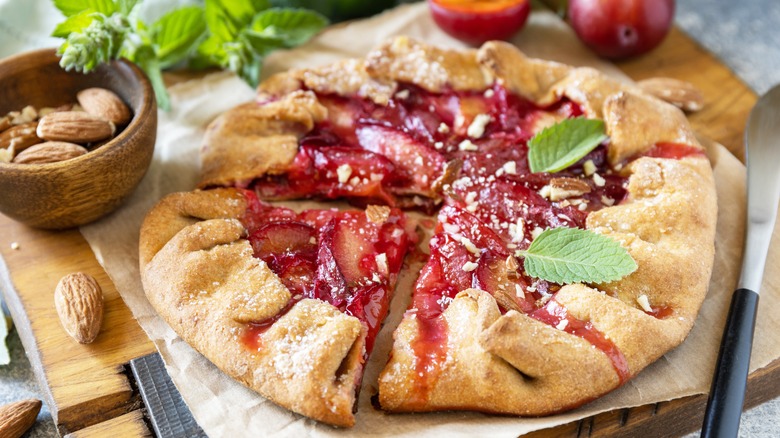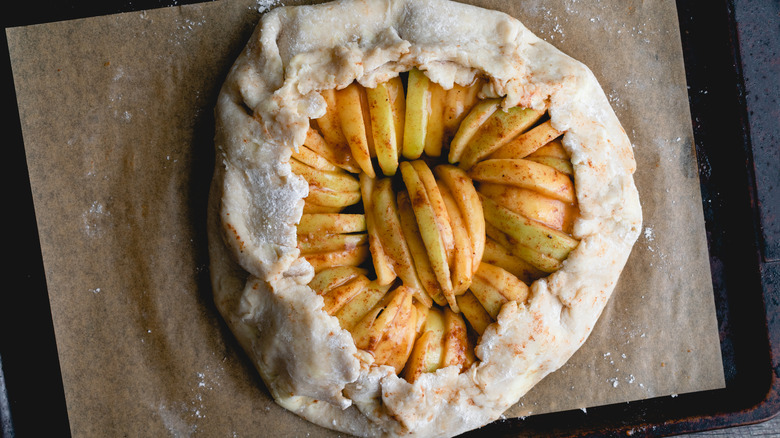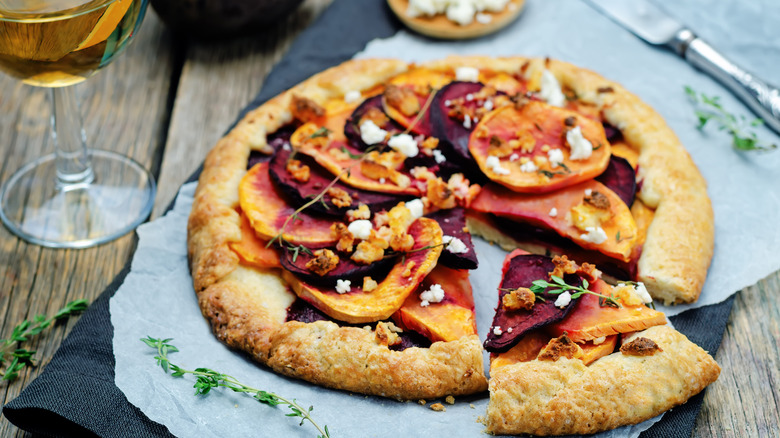Galettes Are The Confidence Builder Every Novice Pie Maker Needs
Baking a pie from scratch can be so rewarding, but there's a huge learning curve every beginner pie baker faces. The baking feat brings to mind a myriad of questions: To use butter or shortening, a pastry cutter or a food processor, and how long to chill the dough? And, you haven't even made the pie dough, let alone shaped and crimped its edges. Luckily, Sarah Fennel, Baker and Owner of the well-known and loved blog Broma Bakery, says there's an easier route to learning the rules of the pie road: Make a galette instead.
Rather, make as many galettes — which is the French culinary term for an open-faced pocket of pastry goodness — as it takes to build your pie-making confidence. "Galettes are a great place to start honing your pie skills," Fennel says. "You don't have to roll out perfect circles or fold intricate lattices ... simply mix your filling and pour it over a rolled-out pie crust, then fold the pie crust up and over the fruit! All the flavors of pie with half the work."
You can assemble and bake a galette in a fraction of the time it takes to prepare a pie, and the results are equally delicious. The rustic pastry method lets you try out pie-baking skills (i.e. achieving a flaky, tender crust and experimenting with flavorful fillings) without the fuss of pristine dough designs or parbaking the crust. A definite baking win.
Galettes are the perfect canvas for pie practice
To make an easy galette, you can pick up fresh, seasonal fruit and make an easy filling with sliced apples, apricots, plums, or peaches. Just mind the liquid when you're preparing the filling to form sugary coatings and jams. "The biggest mistake is not thinking about the water content in your fruit," expert baker Sarah Fennel says. "The higher the water content in your fruit, the longer it's going to take to evaporate out of your pie, which — if you're not careful — can lead to an overcooked crust and undercooked filling in your pie."
To counteract this for fruit pies, Fennel par-cooks half of the fruit in her filling to reduce the water content and start making it gelatinous before baking in the crust. You can try out this filling method with jammy-centered galletes. For simply sliced and sugared fruit fillings, make sure to slice your fruit thinly and avoid overstuffing so the crust and filling both cook adequately. You just need to assemble a relatively thin, even layer of filling before draping the edges of your pie dough in towards the center.
Galettes allow for savory fillings too. This means you can practice making pie and make dinner at the same time. Think about lemony asparagus galettes, or squash, mushrooms, and ricotta immersed in a flaky open-faced pocket of crust. Just drain off any excess moisture from the cheese or sauteed veggies to keep things from getting soggy.
There's a lot to learn when it comes to pie
Learning to bake a pie can seem like a chemistry course. So, Sarah Fennel advises on the most common errors to help pave the way. "Another huge mistake is over-browning your pie crust!" she says. Though she recommends a pie crust protector to keep the outer edges of pies from overcooking, galettes' form makes the baking process more forgiving.
With a galette, there's no need to worry about par-baking or blind-baking the crust or breaking out pie weights. But, you do get to practice techniques like chilling the dough and the formed galette before baking. "Room temperature pie crust won't keep its shape in your oven, and won't lead to as flakey a crust, as the room temperature butter melts more into the flour," Fennel says. "Just 30 minutes in the fridge (or 15 minutes in the freezer) will do the trick!"
Once your galette has chilled, for sweet variations, you can brush it with some egg wash and apply a sprinkling of cinnamon and sugar. Or brush it with a jam glaze after it bakes. Either way, bake your galette on a sheet pan or cast iron skillet until the crust is golden. And, the extra benefit to baking a galette is you don't have to wait as long as you do with a pie to slice into it. Just let it cool down, then serve it warm (with ice cream, if you please).


